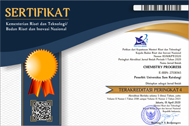GREEN SYNTESIS NANOPARTIKEL PERAK (Ag) MENGGUNAKAN LARUTAN DAUN RUMPUT MACAN (Lantana Camara L)
DOI:
https://doi.org/10.35799/cp.11.2.2018.27938Keywords:
Nanopartikel perak, green synthesis, rumput macanAbstract
ABSTRAK
Nanopartikel telah banyak diaplikasikan dalam beberapa bidang salah satunya yaitu di bidang sensor. Green synthesis merupakan Salah satuh metode yang digunakan untuk mesintesis nanopartikel dengan memafaatkan tumbuhan. Penelitian ini bertujuan untuk mensintesis nanopartikel Ag melalui jalur green syntesis dengan memanfaatkan daun rumput macan dengan menggunakan pelarut akuades dan etanol sebagai reduktor maupun penstabil partikel. pembuatan larutan daun rumput macan dengan metode green synthesis yang selanjutnya digunakan untuk mensintesis nanopartikel perak (Ag). Sintesis nanopartikel Ag dibuat dengan variasi larutan prekursor AgNO3 dengan konsentrasi 1 mM, 2 mM, 3 mM, 4 mM dan 5 mM yang kemudian dicampurkan dengan larutan daun rumput macan dengan perbandingan (18:1 v/v). Selanjutnya distirer dengan kecepatan 1500 rpm selama 1 jam, dianalisis dengan menggunakan spektrofotometer UV-Vis dan Transmission Electron Microscopy (TEM). Hasil penelitian menujukkan bahwa nanopartikel yang disintesis menggunakan pelarut akuades lebih banyak mengahasilkan nanopartikel Ag dibandingkan menggunakan pelarut etanol.
Â
Â
ABSTRACT
Nanoparticles have been widely applied in several fields, one of which is in the sensor field. Green synthesis is one of the methods used to synthesize nanoparticles by utilizing plants. This study aims to conducted synthesize Ag nanoparticles through the green syntesis pathway by utilizing leaf of rumput macan by using distilled water and ethanol as a reducing agent or particle stabilizer. The first stage for this research is by making a solution leaf of rumput macan with the green synthesis method which is then used to synthesize silver (Ag) nanoparticles. Synthesis of Ag nanoparticles was made with a variety of AgNO3 precursor solutions with a concentration of 1 mM, 2 mM, 3 mM, 4 mM and 5 mM which were then mixed with a solution leaf of rumput macan by comparison (18:1 v / v). Then it was distilled with a speed of 1500 rpm for 1 hour, analyzed using UV-Vis spectrophotometer and Transmission Electron Microscopy (TEM). The results showed that nanoparticles which were synthesized using more distilled water distilled water resulted in Ag nanoparticles than using ethanol solvents.
Â













